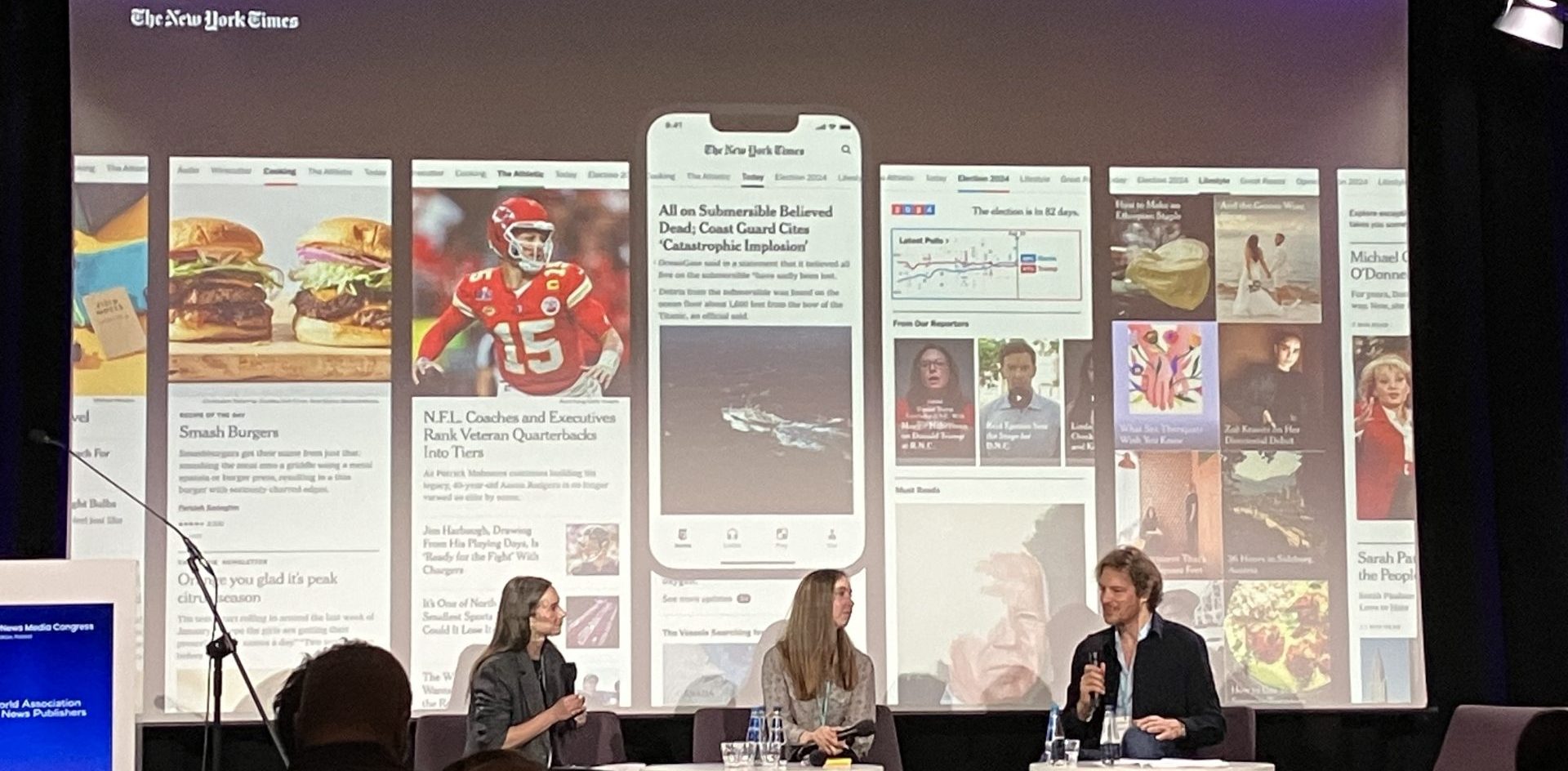
Newsletter
Newsletter
This week, we highlight how to engage audiences using SMS and Esther Kezia Thorpe’s challenge to get real about podcast numbers.
5th October 2022

In the Pugpig weekly media bulletin, Pugpig’s consulting services director Kevin Anderson distills some of the best strategies and tactics that are driving growth in audiences, revenue and innovation at media businesses around the world.
Publishers see storm clouds on the horizon, but for those who have been focused on transforming their businesses during the pandemic, some are quite “bullish”, according to Dean Roper, Director of Insights and Editor-in-Chief for WAN-IFRA. Last year, more than 80% of publishers polled in their World Press Trends report said that they were optimistic, but optimists were in the minority this year, with 55.4% saying that they were pessimistic about the next 12 months. When they asked about sentiment over three years, that is where they found some publishers who were excited about their prospects.
Sign up to get the Media Bulletin in your inbox.
These optimists were buoyed by long-term investments that they were making in data, product management and new revenue streams. Digital revenue – both from readers and ads – are expected to grow by double digits, but with pandemic lockdowns over, events are seen as a key driver of a diverse set of other revenue sources that are expected to grow by 21.5% over the last year.
But it’s also important to note that there is a difference in expected revenue growth between newspapers in developing markets, which expect to see 24% revenue growth in 2022, versus newspapers in developed countries, which only expect to see 8% growth.
Interestingly, in the US, subscription data company Mather Economics forecasts that the number of digital subscribers will surpass that of print subscribers in 2023. The Press Gazette has been collecting closely held digital subscription data from a number of US papers, which highlights the growth and success of digital subscriptions. The Press Gazette found that a number of large metro papers now have 100,000 digital subscribers or more including the Minneapolis Star Tribune with 100,000, The Boston Globe with 244,000 and the Los Angeles Times with 500,000. Other newspapers are growing quickly. The Seattle Times has doubled its digital subscribers in three years and now boasts 81,000.
While there have been deep concerns about local journalism in the US, Peter Doucette, a senior managing director at Mather, told the Press Gazette that there isn’t a magical formula, it’s as simple as having exclusive local content. Doucette used to work at the Boston Globe, and he credits the business with having a clear strategy that has delivered enough revenue to “fund their newsroom twice over”.
It all starts with what you’re solving for and what is your vision. I see a lot of publishers skip that step and they go into execution.
Peter Doucette, Mather Economics, speaking to the Press Gazette
The strategic vision of the Globe and other publishers is driving investment in capabilities such as product development, data analytics and multiple revenue streams that are delivering results, WAN-IFRA found.
It is becoming increasingly clear that perhaps the most crucial foundation for a sustainable business is the relationship publishers build with their audiences and consumers, and at the heart of that is a comprehensive data strategy – especially first-party data.
Dean Roper, WAN-IFRA, from What’s New in Publishing
It can be challenging to create a long-term vision with all of the change and volatility in our world, but for those publishers who have, they can see their way to a brighter future.
At Pugpig, we are frequently asked for benchmarks so that clients can develop KPIs and know what success looks like. Podcasting has been one of the buzzier corners of digital media over the past few years, but Esther Kezia Thorpe of the Media Voices podcast has a bit of a well-argued buzzkill about the format. Using data from Buzzsprout, she found that the average number of listens for a new podcast seven days after it is released is an uninspiring 29. That and other data paint a picture of a market with a long and low tail and a very high and steep head. She asks whether the industry has unrealistic expectations of how many podcast listeners they will have.
For publishers, the expectations are rightly higher. But how much higher? As the podcasting gold rush continues, are we in danger of skewing numbers to try and keep up?
Esther Kezia Thorpe, Media Voices Podcast
She flags up some audience inflation tactics, including ones related to podcasts, that flatter our numbers but ultimately will erode trust in digital media. Fortunately, she has some practical advice on level setting so that publishers can benchmark against their own audience rather than false expectations based on hits like Serial. She wants the metric to be engaged minutes rather than listeners. To support her point, she says that if your website has 10,000 visits a month with an average visit of a minute – which isn’t too far off the average session duration for most sites – you’ve got 10,000 engaged minutes. But if you’ve got a 1000 listeners who listen to your 30-minute podcast, that’s 30,000 engaged minutes. Now, not everyone will listen to the entire podcast, but even if they only listen on average 10 minutes, the point is made.
She suggests looking at your core superfans, which can be based on a mix of sessions per month, frequency and/or recency, or as she suggests take certain actions on your site like subscribe to your newsletters or other products. That is the highly engaged audience who are likely to listen to your podcast. That number will give you a good sense of what to expect for your podcast audience.
There is a lot more good advice in Esther’s post so click on over and give it a read. If subscription-based businesses have taught us anything, it is that it’s easy to be seduced to the dark side of digital media with big numbers of social media or that literally odd story that gets shared outside of your normal market or audience. Instead, audience-focused, subscription-driven businesses are sustained with smaller numbers of highly engaged readers, listeners and viewers. A thousand true fans are worth a lot more than tens of thousands of unknown drive-by clicks.
With all of the shiny technology in the mobile space, sometimes it is important to remember how vital the humble text message can in delivering information, especially during times when 5G connections might be scarce due to disasters. Texting is, after all, the original push notification. David Cohn, the cofounder of texting platform Subtext, highlighted how the service has been used for major news stories, including Hurricane Ian.
There are a number of excellent services out there, like Subtext and Groundsource, that can quickly get a newsroom or any other media company texting.
However, if you want to experiment before making a commitment to a service like this or if you are on a tight budget, Eli Hoff at the Reynolds Journalism Institute outlined how to use pay-per-message services like Twilio to inexpensively try texting.
A texting number, which can be a local area code, costs $1 a month through Twilio. The exact cost of sending or receiving a text varies slightly based on the recipient’s phone carrier, but is generally a little more than a cent. Sending 400 messages and receiving 50 messages costs about $5.50 a month.
Eli Hoff, Reynolds Journalism Institute Innovation Student Staffer
What is attractive about services like Twilio is that you can send out the same message either via text or using a modern messaging service like WhatsApp. The cost for messages is a fraction of the cent in the US, and besides the attractive pricing, these services are two-way. People who join the service can also send messages back to the reporter or editor using the service.
This kind of two-way communication can provide life-saving information that reporters can disseminate during disasters. But there are also incredible examples of using texting to engage audiences in novel ways.
One of my favourite examples was a project by Manoush Zomorodi, who before she was the host of the Ted Radio Hour hosted WNYC’s Note to Self, a programme that explored our relationship to technology. In 2016, she did one of the most innovative experiments in trans-media engagement that I’ve seen, a five-day project called Infomagical. The goal of the project was to help people overcome information overload. Participants first chose a goal that they wanted to achieve during the five days such as spend more time with their family or improve their news consumption, and then they received a link each day that led to a podcast with tips on how they could better manage their information diet. Each day, they rated how successful they had been in achieving their goal. They sent 300,000 text messages to 15,000 people over the five days, and they received 1700 voice mails in response to the project. By the end, Manoush felt like this was a conversation between her and her listeners.
In a time when media outlets are trying to increase engagement to grow their subscriber or membership base, this kind of conversational experiment seems like a great template for experimentation. Moreover, texting services could drive audience acquisition for apps, progressively moving people through your conversion funnel. And it all begins with the humble text message.
If you’re interested in experiments with app discovery and user acquisition, please get in touch with our consulting services team at info@pugpig.com.
Industry News
Here are some of the most important headlines about the business of news and publishing as well as strategies and tactics in product management, analytics and audience engagement.

Newsletter

Newsletter

Newsletter

Newsletter

Newsletter